
The first item described below is a bibliography of Czech and Slovak encyclopedias. The remaining items are annotations for some of the major encyclopedias issued in Czech or Slovak. Biographical entries have been chosen to illustrate the encyclopedias.
Bibliografie encyklopedicke literatury ceske a slovenske vydane v letech 1860 az 1967.
Janda, Bohumil; Dedicova, Julie. Praha: Encyklopedicky institut CSAV, 1969. (Mala rada ; sv. 3). 24 p.
U of I Library Call Number: International & Area Studies Slavic — Czech/Slovak Reference 016.03786 J25b
Although this bibliography is only 23 pages long, it covers the range of Czech and Slovak encyclopedias. It divides the citations into two time periods, 1860-1945 and 1945-1967. Within these sections the encyclopedias are listed by subject beginning with the general encyclopedic works and then the various scientific and technical ones, followed by encyclopedias for the social sciences and humanities. Categories include biology, psychology, literature, music, etc. Unfortunately, the citations are not annotated. Some dictionaries are also included. See the entries below which appear in the first section on religion.

![]()
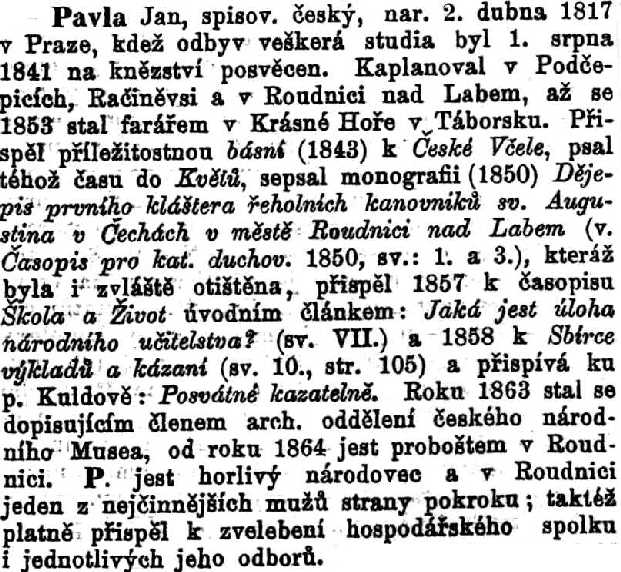
Slovnik naucny and Nazorny atlas k Slovniku naucnemu.
Frantisek L. Rieger ; Malý, Jakub Josef Dominik. Praha: 1860-74. + Rieger, F.L. ; Zelený, Václav. V Praze : I.L. Kober, 1865.
U of I Library Call Number: Main Stacks 037.86 R44s, v.1-11, sup.,v.1-5, sup.,plates, 11 vols. and 5 v. in 1 + plates
Rieger’s Slovnik naucny is the first important encyclopedia published in Czech. Doplnky are included in the second half of volume 10 and all of volume 11. The entries, many of which are significant in length, cover general topics as well as ones specific to Czech and Slovak. Some entries have references for further reading. Note that for names only one entry is given. Individuals with the same name will be covered in the same entry, but distinguished from each other by numerals in bold face. A list of the contributors with their initials and a key to the abbreviations are included.  An interesting feature that appears in volume one is an overview of the number of subscribers to the encyclopedia in 1860 broken down by region and then city. The Nazorny atlas is not an atlas, but rather a supplemental volume that contains extensive articles grouped into the following five sections: “Art,” “Ethnography and history,” “Warfare and the military,” “Industry,” “Science.” Although there are no illustrations or maps in the body of the encyclopedia, the supplemental Nazorny atlas has a volume of beautiful black and white plates to illustrate its contents. Entries are arranged alphabetically. There are cross references to accommodate variant spellings and related terms. See the image of the right for the entry on the 19th-century Czech writer, Jan Pavla.
An interesting feature that appears in volume one is an overview of the number of subscribers to the encyclopedia in 1860 broken down by region and then city. The Nazorny atlas is not an atlas, but rather a supplemental volume that contains extensive articles grouped into the following five sections: “Art,” “Ethnography and history,” “Warfare and the military,” “Industry,” “Science.” Although there are no illustrations or maps in the body of the encyclopedia, the supplemental Nazorny atlas has a volume of beautiful black and white plates to illustrate its contents. Entries are arranged alphabetically. There are cross references to accommodate variant spellings and related terms. See the image of the right for the entry on the 19th-century Czech writer, Jan Pavla.
![]()
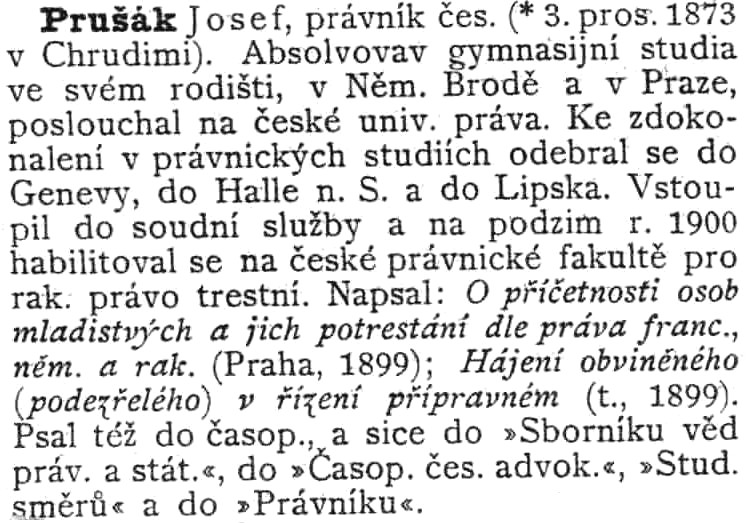
Ottuv slovnik naucny: illustrovana encyclopedie obecnych vedomosti.
Ottuv slovnik naucny nove doby: Dodatky k velikemu Ottovu slovniku naucnemu.
Otto, Jan. Praha, 1888-1909 and 1930-43.
U of I Library Call Number: Main Stacks Reference 037.86 Ot8, v.1-28. International & Area Studies Slavic– Czech/Slovak Reference 037.86 Ot82, v.1-6, 1930-43
Hathi Trust Digital Library link: http://catalog.hathitrust.org/Record/007913708
The Ottuv slovnik naucny, the second important encyclopedia published in Czech, is also the largest and most comprehensive. The first, Rieger’s, is discussed in the entry above. The original 28 volumes were published before 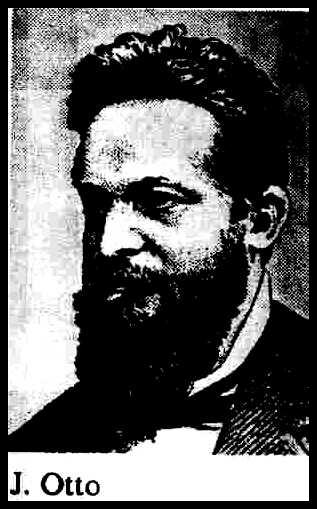 World War I and the Dodatkyupdate it to the early 1940’s. The entries, many of which are significant in length, cover general topics as well as ones specific to Czech and Slovak. Some entries have references for further reading. Illustrations and fold-out color maps enhance the text. An irritating oversight is the lack of a key to the abbreviations used in the encyclopedia, although this is corrected in the Dodatky. A list of the contributors and their initials appears at the end of volume 27. Volume 28 of the original set comprises over 1100 pages of additions to the previous 27 volumes. The Dodatky end with the letter U. Entries are arranged alphabetically. There are cross references to accommodate variant spellings and related terms. See above for the entry on the Czech lawyer, Josef Prusak. Note that the entry gives some of his publications and informs the reader in which journal publications his work appeared.
World War I and the Dodatkyupdate it to the early 1940’s. The entries, many of which are significant in length, cover general topics as well as ones specific to Czech and Slovak. Some entries have references for further reading. Illustrations and fold-out color maps enhance the text. An irritating oversight is the lack of a key to the abbreviations used in the encyclopedia, although this is corrected in the Dodatky. A list of the contributors and their initials appears at the end of volume 27. Volume 28 of the original set comprises over 1100 pages of additions to the previous 27 volumes. The Dodatky end with the letter U. Entries are arranged alphabetically. There are cross references to accommodate variant spellings and related terms. See above for the entry on the Czech lawyer, Josef Prusak. Note that the entry gives some of his publications and informs the reader in which journal publications his work appeared.
![]()
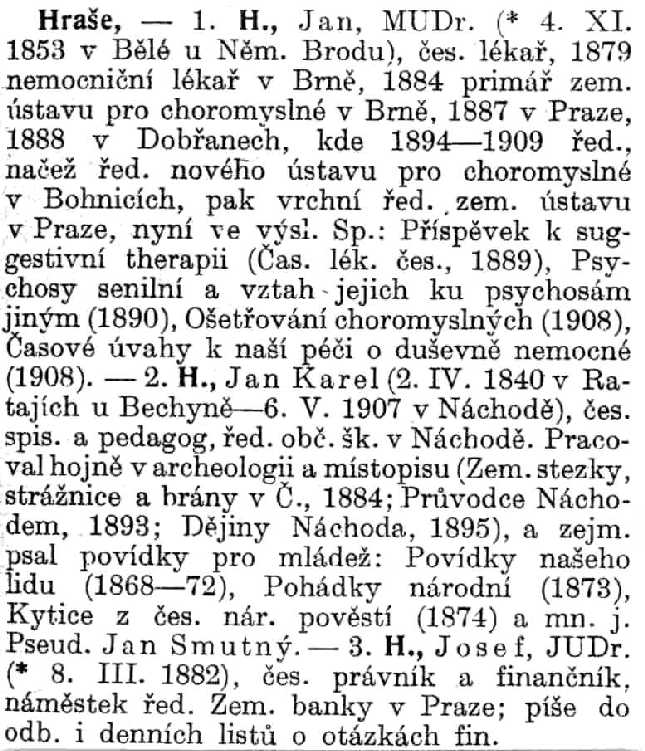
Masarykuv slovnik naucny: lidove encyclopedie vseobecnych vedomosti.
Praha: Ceskoslovensky kompas, 1925-33. 7 vols.
U of I Library Call Number: International & Area Studies Slavic (Czech/Slovak) Reference. Oak Street Facility 037.86 M371, v.1-7
This is the third important encyclopedia published in Czech. The first two, Rieger’s and the Ottuv, are discussed in the entries above. Although it is smaller than its predecessors, it is still quite comprehensive. Publication of this new encyclopedia was undertaken to update the information available in the previous ones that were completed in 1874 and 1908 and to reflect the new status of the Czech and Slovak people who were now living in their own state, Czechoslovakia. The entries cover general topics as well as ones specific to Czechs and Slovaks. 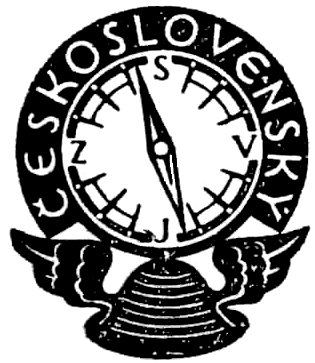 Some entries have references for further reading. Note that for names only one entry is given. Individuals with the same name will be covered in the same entry, but distinguished from each other by numerals and letters in bold face. Illustrations and fold-out color maps enhance the text. Entries are arranged alphabetically. There are cross references to accommodate variant spellings and related terms. See below for the entry on Jan Hrase, the Czech doctor, and two other people named Hrase, Jan Karel, the pedagogue, and Josef, the lawyer and financier.
Some entries have references for further reading. Note that for names only one entry is given. Individuals with the same name will be covered in the same entry, but distinguished from each other by numerals and letters in bold face. Illustrations and fold-out color maps enhance the text. Entries are arranged alphabetically. There are cross references to accommodate variant spellings and related terms. See below for the entry on Jan Hrase, the Czech doctor, and two other people named Hrase, Jan Karel, the pedagogue, and Josef, the lawyer and financier.

Mala Ceskoslovenska encyklopedie.
Kvasil, Bohumil; Riman, Josef, eds. Praha: Academia, 1984-1987. 6 vols.
U of I Library Call Number: International & Area Studies Slavic — Czech/Slovak Reference 037.86 M29 v.1-6
Produced by scholars at the Czechoslovak Academy of Sciences, this 6 volume encyclopedia provides shorter entries, but more up-to-date ones than the previous encyclopedias. This is a general encyclopedia so entries appear on all topics. Biographical entries gives dates of life, brief statements on the historical significance of the person, and often a portrait. Although there are no bibliographic references for further reading at the end of entries, there are many illustrations that complement the texts. See the entry on the right for the linguist, Vilem Mathesius.
![]()
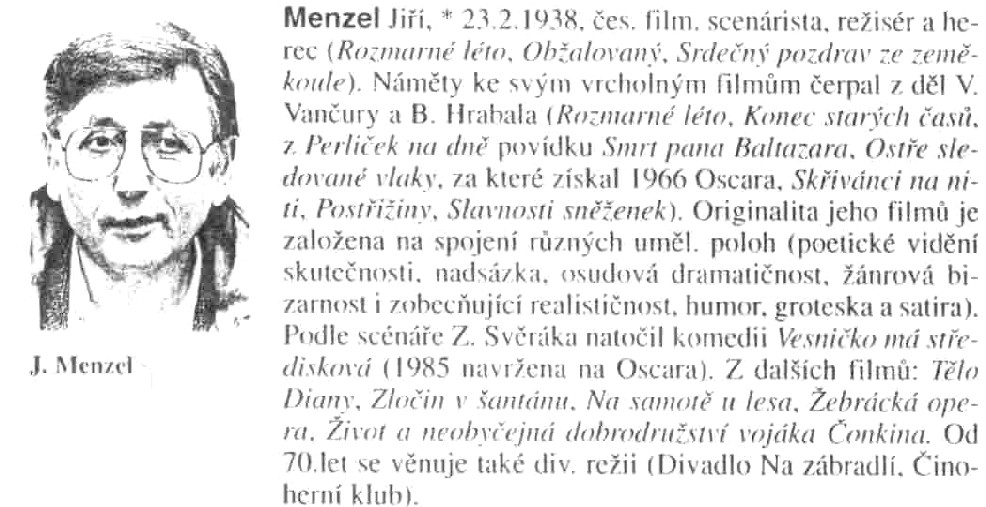
Vseobecna encyklopedie ve ctyrech svazcich.
Honzáková, Marie. Praha: Nakladatelsky dum OP, 1996-1998. 4 vols.
U of I Library Call Number: Main Stacks Reference 037.86 V9691995
This encyclopedia in four volumes is the latest addition to the collection of Czech general encyclopedias. Although there is no introduction explaining the rationale or methodology behind the compilation of a new encyclopedia in Czech, there is a long list of contributors at the back of each volume. This encyclopedia does not just provide updated information over the previous one, but as a post-Communist publication it also has different entries. For example, the previous encyclopedia had numerous entries for various Russian historical figures which are lacking in this encyclopedia. Biographical entries provide dates of life, brief statements of historical significance, and often a portrait. Entries are brief with no bibliographic references, but there are many color and black and white illustrations. See the entry on the left for the Czech director Jiri Menzel.
![]()
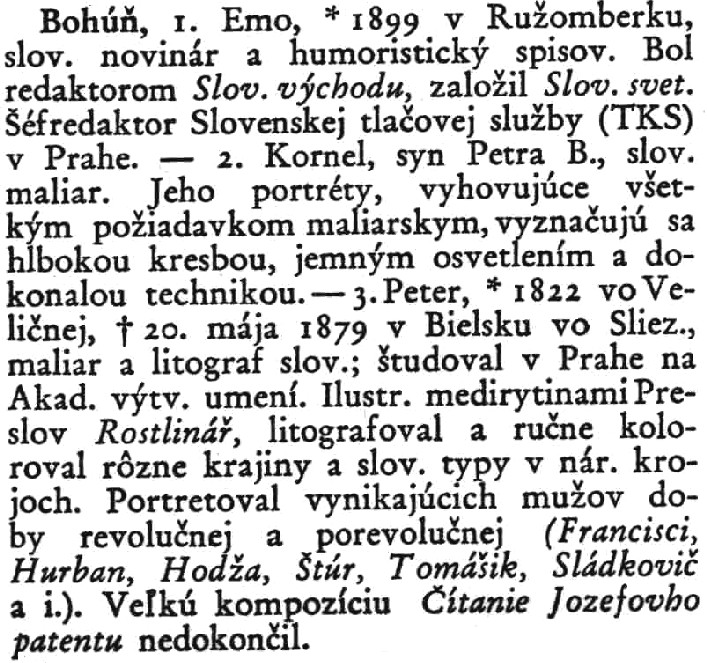
lovensky naucny slovnik. Prirucna encyklopedia vedomosti v troch dieloch.
Bujnak, Pavel. Bratislava-Praha: Litevna, 1932. 3 vols.
U of I Library Call Number: International & Area Studies Slavic — Czech/Slovak Reference 037.87 Sl58 v.1-3
This is the first Slovak encyclopedia. Although the entries are quite brief and there are no bibliographical references, there may 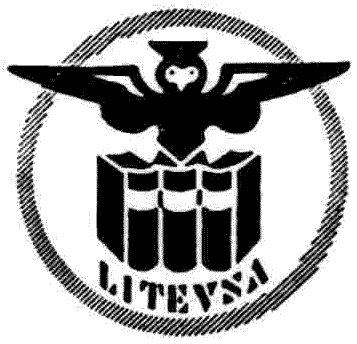 be information in this set that would be more difficult to find elsewhere. Entries are clearly marked, appear in a pleasing typeface and are accompanied by many illustrations. There are even some fold out color maps. Biographical entries provide full name, dates of life, a brief state of significance and mentions of major works. Occasionally a portrait also is included. All biographical entries for the same surname appear under one heading. See the entry on the right which covers three different men named Bohun.
be information in this set that would be more difficult to find elsewhere. Entries are clearly marked, appear in a pleasing typeface and are accompanied by many illustrations. There are even some fold out color maps. Biographical entries provide full name, dates of life, a brief state of significance and mentions of major works. Occasionally a portrait also is included. All biographical entries for the same surname appear under one heading. See the entry on the right which covers three different men named Bohun.
![]()
Encyklopedia Slovenska.
Bratislava: Veda, 1977-1982. 6 vols.
U of I Library Call Number: International & Area Studies Slavic — Czech/Slovak Reference 914.373503 En19 v.1-6
This multi-volume encyclopedia for Slovakia was issued under the aegis of the Encyclopedic Institute of the Slovak Academy of Sciences. Although this is a large general encyclopedia, it focuses on subjects and people of importance to Slovakia. Thus when you read about a general subject such as archaeology, you will find a description of what archaeology is, but with particular reference to Slovakia. Nor will you find entries for famous literary figures from Russian, Britain or the United States, but only those from Slovakia or the Czech Republic. The encyclopedia is illustrated with both black and white and color pictures. Most entries are a good paragraph in length with some topics being given several columns of coverage. There are no bibliographic references, but there is a list of scholars who contributed to the compilation. Follow the link to view an entry for the Slovak bibliographer, Michal Potemra.
![]()
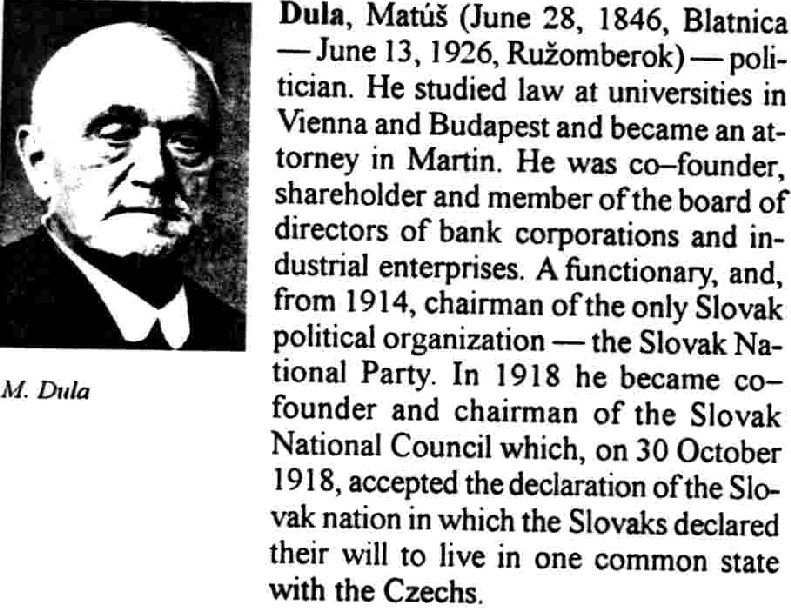
Slovakia and the Slovaks. A concise encyclopedia.
Strhan, Milan. ; Daniel, David P. Bratislava: Encyclopedical Institute of the Slovak Academy of Sciences, 1994. 727 p.
U of I Library Call Number: International & Area Studies Slavic (Czech/Slovak) Reference 037.87 Sl581
This English-language encyclopedia of Slovakia provides entries on many cultural, political and economic topics as they pertain to Slovakia. There are also biographical entries for famous Slovaks and memorable events in Slovak history. It was produced by scholars at the Slovak Academy of Sciences. None of the articles have bibliographic references, but there there are many illustrations and a list of contributors. Biographical entries include dates of life, place of birth and death, a brief statement of historical significance, and mentions of major works produced by the figure. Often there are portraits as well. See the entry on the left for the politician Matus Dula.
![]()